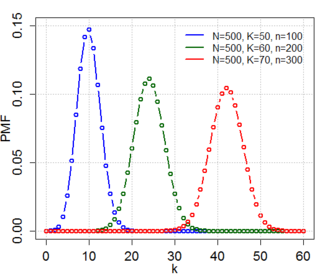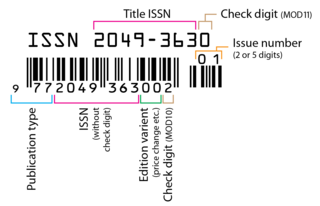Related Research Articles

In probability theory and statistics, the hypergeometric distribution is a discrete probability distribution that describes the probability of successes in draws, without replacement, from a finite population of size that contains exactly objects with that feature, wherein each draw is either a success or a failure. In contrast, the binomial distribution describes the probability of successes in draws with replacement.
In mathematics, the Gelfand–Naimark theorem states that an arbitrary C*-algebra A is isometrically *-isomorphic to a C*-algebra of bounded operators on a Hilbert space. This result was proven by Israel Gelfand and Mark Naimark in 1943 and was a significant point in the development of the theory of C*-algebras since it established the possibility of considering a C*-algebra as an abstract algebraic entity without reference to particular realizations as an operator algebra.
In mathematics, a generalized hypergeometric series is a power series in which the ratio of successive coefficients indexed by n is a rational function of n. The series, if convergent, defines a generalized hypergeometric function, which may then be defined over a wider domain of the argument by analytic continuation. The generalized hypergeometric series is sometimes just called the hypergeometric series, though this term also sometimes just refers to the Gaussian hypergeometric series. Generalized hypergeometric functions include the (Gaussian) hypergeometric function and the confluent hypergeometric function as special cases, which in turn have many particular special functions as special cases, such as elementary functions, Bessel functions, and the classical orthogonal polynomials.
In mathematics, the Gelfand representation in functional analysis has two related meanings:
In mathematics, a confluent hypergeometric function is a solution of a confluent hypergeometric equation, which is a degenerate form of a hypergeometric differential equation where two of the three regular singularities merge into an irregular singularity. There are several common standard forms of confluent hypergeometric functions:

Richard "Dick" Allen Askey is an American mathematician, known for his expertise in the area of special functions. The Askey–Wilson polynomials are on the top level of the (q)-Askey scheme, which organizes orthogonal polynomials of (q-)hypergeometric type into a hierarchy. The Askey–Gasper inequality for Jacobi polynomials is essential in de Brange's famous proof of the Bieberbach conjecture.
In mathematics, the hypergeometric function of a matrix argument is a generalization of the classical hypergeometric series. It is a function defined by an infinite summation which can be used to evaluate certain multivariate integrals.
In mathematics, a matrix coefficient is a function on a group of a special form, which depends on a linear representation of the group and additional data. For the case of a finite group, matrix coefficients express the action of the elements of the group in the specified representation via the entries of the corresponding matrices.
In mathematics the Selberg integral is a generalization of Euler beta function to n dimensions introduced by Atle Selberg (1944).
In mathematics, the X-ray transform is an integral transform introduced by Fritz John in 1938 that is one of the cornerstones of modern integral geometry. It is very closely related to the Radon transform, and coincides with it in two dimensions. In higher dimensions, the X-ray transform of a function is defined by integrating over lines rather than over hyperplanes as in the Radon transform. The X-ray transform derives its name from X-ray tomography because the X-ray transform of a function ƒ represents the attenuation data of a tomographic scan through an inhomogeneous medium whose density is represented by the function ƒ. Inversion of the X-ray transform is therefore of practical importance because it allows one to reconstruct an unknown density ƒ from its known attenuation data.
In mathematics, an elliptic hypergeometric series is a series Σcn such that the ratio cn/cn−1 is an elliptic function of n, analogous to generalized hypergeometric series where the ratio is a rational function of n, and basic hypergeometric series where the ratio is a periodic function of the complex number n. They were introduced by Frenkel & Turaev (1997) in their study of elliptic 6-j symbols.
In the mathematical theory of special functions, Schwarz's list or the Schwartz table is the list of 15 cases found by Hermann Schwarz when hypergeometric functions can be expressed algebraically. More precisely, it is a listing of parameters determining the cases in which the hypergeometric equation has a finite monodromy group, or equivalently has two independent solutions that are algebraic functions. It lists 15 cases, divided up by the isomorphism class of the monodromy group, and was first derived by Schwarz by methods of complex analytic geometry. Correspondingly the statement is not directly in terms of the parameters specifying the hypergeometric equation, but in terms of quantities used to describe certain spherical triangles.

The (one-dimensional) Holtsmark distribution is a continuous probability distribution. The Holtsmark distribution is a special case of a stable distribution with the index of stability or shape parameter equal to 3/2 and skewness parameter of zero. Since equals zero, the distribution is symmetric, and thus an example of a symmetric alpha-stable distribution. The Holtsmark distribution is one of the few examples of a stable distribution for which a closed form expression of the probability density function is known. However, its probability density function is not expressible in terms of elementary functions; rather, the probability density function is expressed in terms of hypergeometric functions.

Andrei Vladlenovich Zelevinsky was a Russian-American mathematician who made important contributions to algebra, combinatorics, and representation theory, among other areas.
Kazuhiko Aomoto is a Japanese mathematician who introduced the Aomoto-Gel'fand hypergeometric function and the Aomoto integral.
Vladimir Solomonovich Retakh is a Russian-American mathematician who made important contributions to Noncommutative algebra and combinatorics among other areas.
References
- Gelfand, I. M. (1986), "General theory of hypergeometric functions", Doklady Akademii Nauk SSSR, 288 (1): 14–18, ISSN 0002-3264, MR 0841131 (English translation in collected papers, volume III.)
- Aomoto, K. (1975), "Les équations aux différences linéaires et les intégrales des fonctions multiformes", J. Fac. Sci. Univ. Tokyo, Sect. IA Math.22, 271-229.

Israel Moiseevich Gelfand, also written Israïl Moyseyovich Gel'fand, or Izrail M. Gelfand was a prominent Soviet mathematician. He made significant contributions to many branches of mathematics, including group theory, representation theory and functional analysis. The recipient of many awards, including the Order of Lenin and the Wolf Prize, he was a Fellow of the Royal Society and professor at Moscow State University and, after immigrating to the United States shortly before his 76th birthday, at Rutgers University.

An International Standard Serial Number (ISSN) is an eight-digit serial number used to uniquely identify a serial publication, such as a magazine. The ISSN is especially helpful in distinguishing between serials with the same title. ISSN are used in ordering, cataloging, interlibrary loans, and other practices in connection with serial literature.
Mathematical Reviews is a journal published by the American Mathematical Society (AMS) that contains brief synopses, and in some cases evaluations, of many articles in mathematics, statistics, and theoretical computer science. The AMS also publishes an associated online bibliographic database called MathSciNet which contains an electronic version of Mathematical Reviews and additionally contains citation information for over 3.5 million items as of 2018.